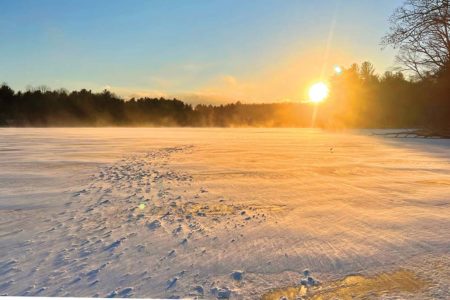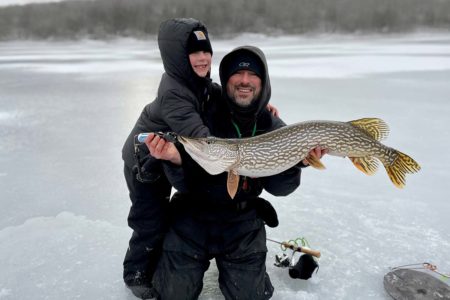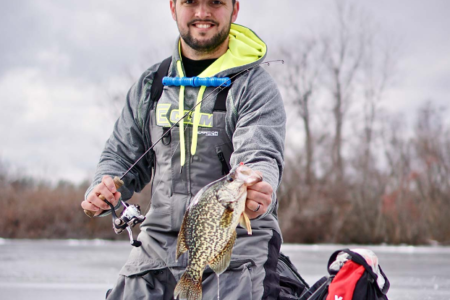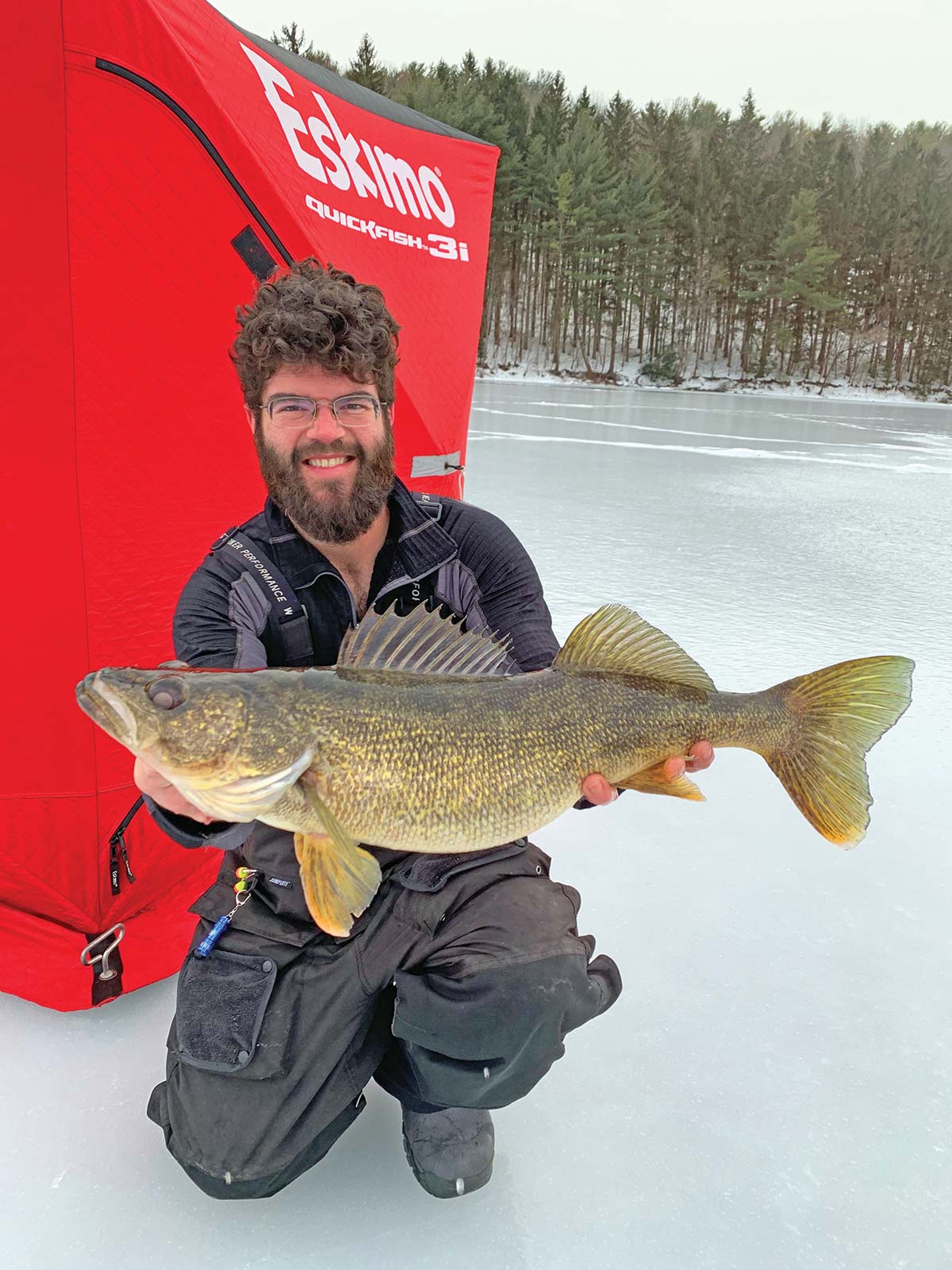
Bundle up and break the ice with a personal best this month.
Ideally, once late season hits our favorite fishing holes begin freeze over. While many will drill a hole for fun, catch a few panfish, maybe a bass or pickerel, some take it up a notch and really go for the trophy. It may be a musky, possibly a pike, or maybe even a trophy walleye!
Yes, you can get your new PB (personal best) through the ice, not just while mid-summer trolling drop-offs. In fact, many anglers prefer the “hardwater” for trophy walleye over the open water season.
While fishing the Lehigh River with a guide friend of mine, Steve Kolnik of Gravy Boat Guide Service, we discussed some of his favorite tactics on getting big walleye mid-winter.
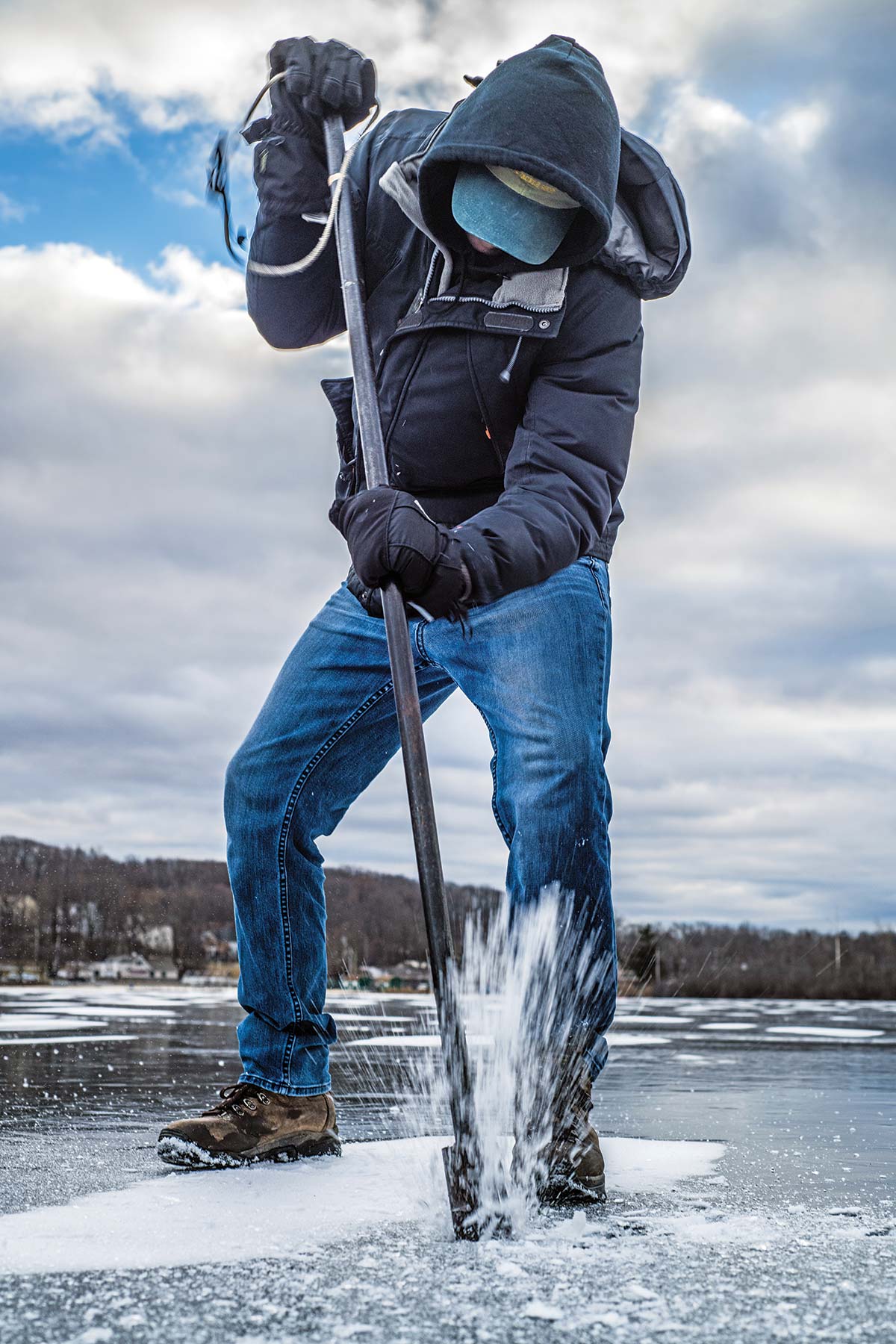
Where To Drill
For starters, it is good first step to research lakes known for holding big walleye. Wasting your time in a lake that hasn’t been stocked in the last 20 years will likely not produce many walleye at all; best to focus your time on a body of water with a known healthy population. Big lakes like Oneida in New York are a known producer of large walleyes and well worth the trip. But even if your local lake holds a sporting population, it still may hold that trophy fish.
Once you’ve identified an icy location to fish, the next question to answer is where to drill our first hole. Kolnik said he prefers to look for a sharp drop-off in the 15- to 20-foot range on his map. Many ice anglers also use portable sonar that can actually shoot through the ice, offering a pretty good idea of depth and structure before drilling a hole. Also finding bait on your sonar is a sign you are in the right location, the closer to deeper water the better.
Walleye will be difficult to spot on the sonar since they will hug the bottom tightly. While many anglers refuse to use Fish ID, this is one time I prefer to use it. It can tell the difference between a log or rock, and a nice fish. In any case, you are essentially looking for ideal habitat for a hungry walleye.
Drilling a few holes at your target area and a couple a bit shallower, as well as a few in deeper water is ideal. You want to have your bases covered if the fish move shallow or deep depending on weather or changing conditions. A good practice if you fish a body of water year-round is to mark your waypoints on your sonar or phone if using mobile charting apps like Navionics. It’s a good bet that any structure holding walleye and other gamefish in the fall will still hold those fish once frozen over.
Remember, once you reach a depth of 25 feet or so you’ll find water temps of around 50 to 57 degrees throughout the year, although this of course may vary by lake. Fish at that depth will behave much the same in October as they will in February. Finding good structure such as a rock pile, old large stump, or outcropping could be a gold mine and a magnet for holding fish.
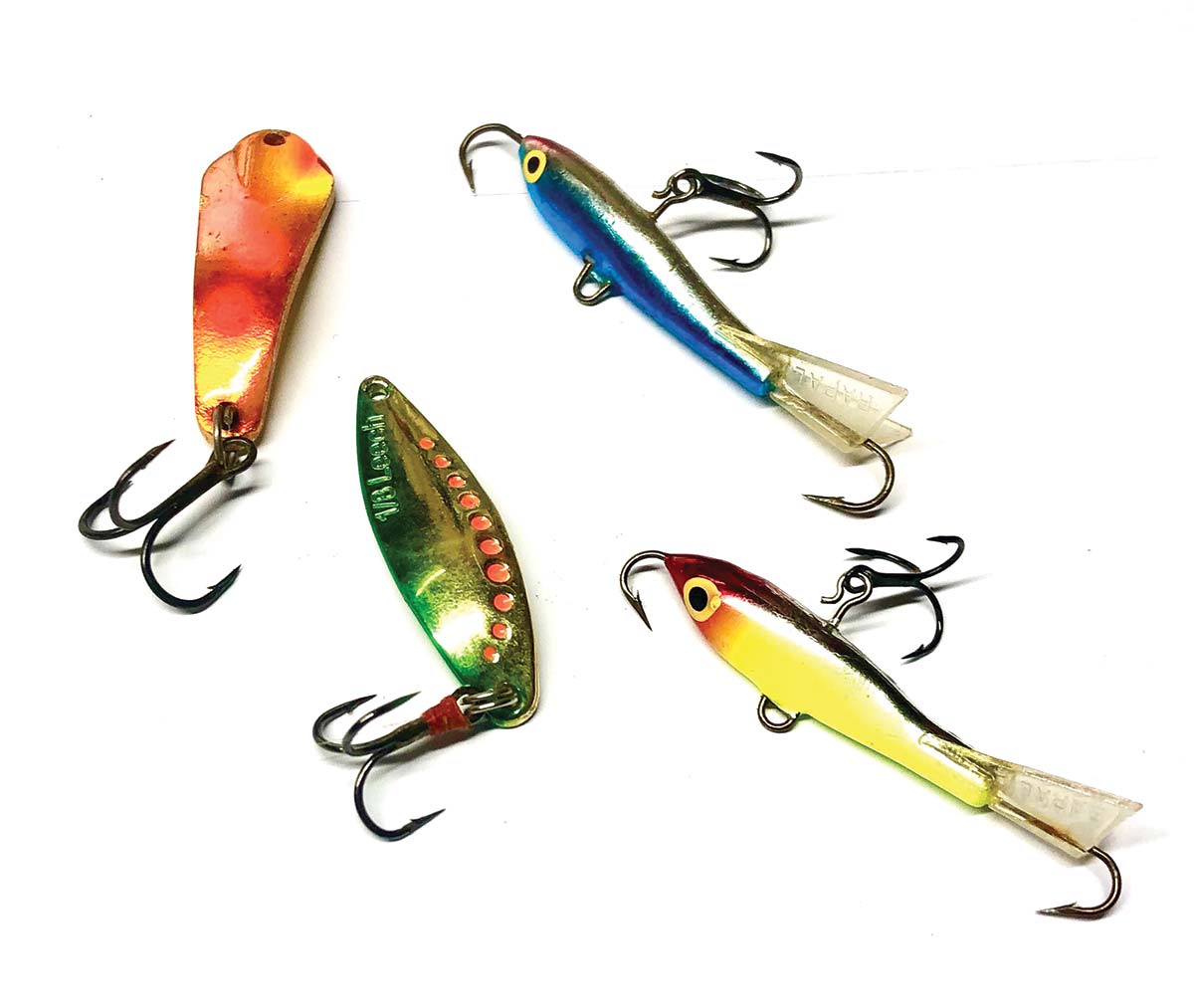
The Presentation Principle
With your area in mind and your holes drilled, it’s time to think presentation. Traditional “tip ups” are a good start and are often set with live shiners, leaches, or whatever bait is available in the area. You can set several tip-ups around the area keeping some in the ideal zone, and others deep or shallow to cover as much water as possible. Rules vary in different states on how many are allowed by law. For example, New Jersey state regulations state “No more than five devices per person may be used when fishing through the ice,” which includes both rods and tip-ups; same in Pennsylvania where the Pennsylvania Fish & Boat Commission states “It is unlawful while ice fishing to use more than five fishing devices, which may consist of rods, hand lines, tip-ups, or any combination.” Be sure to check the regs in the area you plan to fish!
Keep in mind that these will be your “passive baits,” so set them, let them swim or squirm until you get a hit. Similarly, check them about every half hour or so and change baits as needed. Jaw Jackers, if allowed in your area, are also a great “set it/forget it” style; they will even set the hook for you when hit. These will also accommodate a short ice spinning rod setup that will let you fight the fish in a more conventional manner vs. handlining a tip up. This is certainly preferred when trying to land big fish.
While using the passive gear, Kolnik told me he prefers to use one active tactic. By this I mean actively standing at the ice hole working a lure on a jigging rod. Vertical jigging has produced some of his largest fish, so being prepared for the trophy is critical. Small ice spinning gear will just leave you disappointed if that trophy does come along. Have the right gear to go after that larger fish. A heavy ice rod capable of a 15-pound fish or more is a must! It may not be just a large walleye you hook into, as large musky, pike, or even a striper could be a surprise catch depending on the lake you’re fishing, so you need to be ready! Kolnik usually spools up with at least 10-pound braided line with a good 6- to 8-pound fluorocarbon leader on the ice. That fluoro leader is critical when chasing mature “line shy” trophy’s in clear cold water.
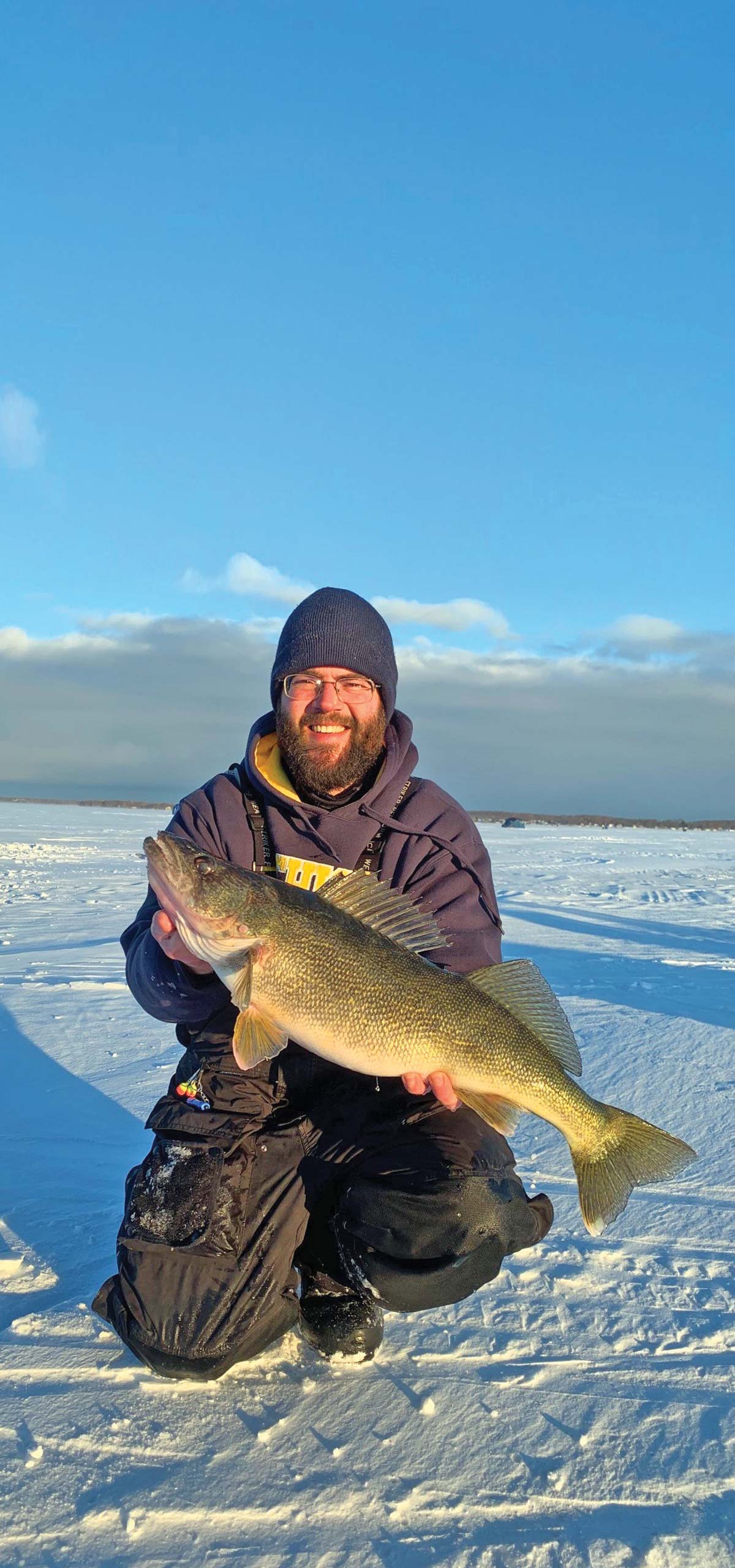
Jig & Rig Recommendations
So while we have the live bait swimming away on our tip ups, what baits or lures are best for vertical jigging? This is often a matter of personal preference, and personal confidence, but a good start will be a few proven baits. Small flashy spoons such as a half-ounce Hopkins, the Swedish Pimple, or Clam Pinhead Pro are a good start. More aggressive, active baits like the Rapala Jigging Rap are prime for catching the attention of a trophy walleye.
When vertical jigging, working the bait aggressively with something like the Rapala Jigging Rap can really get the attention of the fish by “pounding the bottom” to make that lure dart and swim. While using spoons, it is a more subtle, teasing presentation. You want that lure to flash and dance slowly if front of the fish. Either one you choose, make it a tempting meal they cannot resist!
| ABOUT THE AUTHOR |
| After 40 years as a senior executive in the aerospace industry, George Schauer decided to pursue his passion of videography in the great outdoors as Pennsylvania’s “Pocono Outdoors Guy” while launching Lone Fish Studios with video and production services based out of Pennsylvania’s Pocono mountain region. Find George through his website at poconooutdoorsguy.com and catch the Pocono Outdoors Guy’s weekly video updates for the New Jersey, Delaware Bay edition of The Fisherman on our YouTube channel at www.youtube.com/c/thefishermanmagazine |
Keep an eye on you electronics while jigging. Many systems now use a “Live” shot of what’s happening; you can actually see that fish come up to your bait while you tease that trophy into striking! Also if it turns away, you can immediately let the lure fall, and coax it back for another look. Heart-pounding at the least, but that’s what it’s all about.
The presentation for each style of bait is different. Both are effective depending on conditions and the mood of the fish. I feel it is always best to start with a more aggressive presentation and slow down if I get no response. Once you do manage to get bit, you have now zeroed in on the ideal presentation for that day (and it does change daily). Make note of the depth your first catch was made, as you may need to move your setups if they continue to not produce at their current depth. Move them deeper/shallower to align more with the successful setup.
Getting to know a body of water year round is the best way to land that trophy. It takes time and patience, but persistence will pay off. Keep a log of what is working, conditions, depth, lure, etc., and with a little time and effort, you could be getting your own cover photo with that trophy walleye caught on the ice.

